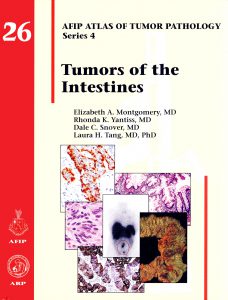Tumors of the intestines
AUTHOR : –
CALL NO : WI435 T925 2017
IMPRINT : Washington, D.C. : American Registry of Pathology, c2017
There have been many advances in the pathology of intestinal tumors since the publication of the Third Series Intestines Fascicle in 2003, but many of the foundations of intestinal tumor diagnosis remain tried and true. Tubular adenomas are still tubular adenomas, but better understanding of serrated polyps has been a key advance in the years since the publication of the Third Series volume. Additionally, developments in molecular biology of colorectal carcinoma have allowed for targeted therapy and refinements to our evaluation of Lynch syndrome, which was termed hereditary nonpolyposis colorectal carcinoma (HNPCC) in the past. Our understanding of other polyposis syndromes has similarly blossomed in the past 15 years. Neuroendocrine tumors have been reclassified in the 2010 World Health Organization classification of gastrointestinal tumors. The molecular basis of gastrointestinal stromal tumors of the intestines has been a subject of great interest as well. In producing this update, this group of authors has enjoyed working together in gathering images and information to update this edition of the Intestines atlas. In doing so, we stand on the shoulders of giants before us, namely Drs. Robert H. Riddell, Robert E. Petras, Geraint T. Williams, and Leslie H. Sobin.
While many areas of intestinal tumor pathology are without controversy, the classification and nomenclature for appendiceal tumors remain a subject of debate, including among ourselves. We have attempted to offer information on the various divergent viewpoints where they exist for this topic and others. Our efforts have been synergistic, and we hope that readers will enjoy the many interesting illustrations that we were able to amass.
Source : www.arppress.org/product-p/4f26.htm




